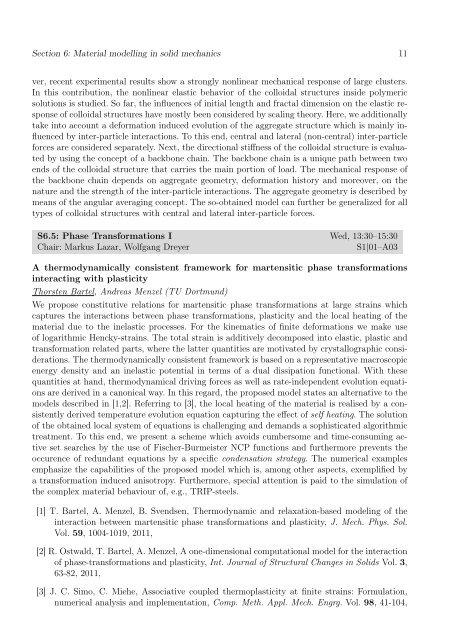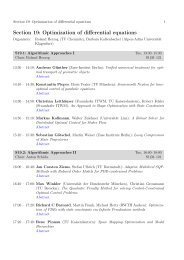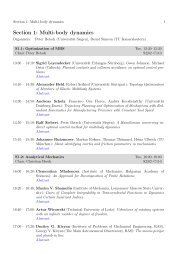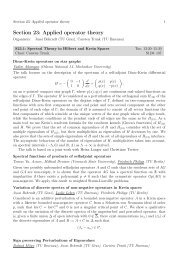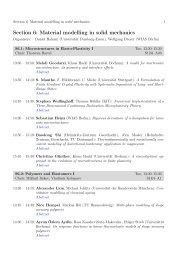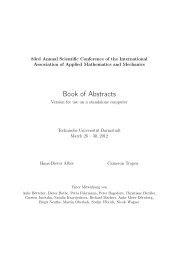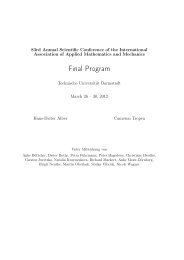Section 6: Material modelling in solid mechanics - GAMM 2012
Section 6: Material modelling in solid mechanics - GAMM 2012
Section 6: Material modelling in solid mechanics - GAMM 2012
Create successful ePaper yourself
Turn your PDF publications into a flip-book with our unique Google optimized e-Paper software.
<strong>Section</strong> 6: <strong>Material</strong> <strong>modell<strong>in</strong>g</strong> <strong>in</strong> <strong>solid</strong> <strong>mechanics</strong> 11<br />
ver, recent experimental results show a strongly nonl<strong>in</strong>ear mechanical response of large clusters.<br />
In this contribution, the nonl<strong>in</strong>ear elastic behavior of the colloidal structures <strong>in</strong>side polymeric<br />
solutions is studied. So far, the <strong>in</strong>fluences of <strong>in</strong>itial length and fractal dimension on the elastic response<br />
of colloidal structures have mostly been considered by scal<strong>in</strong>g theory. Here, we additionally<br />
take <strong>in</strong>to account a deformation <strong>in</strong>duced evolution of the aggregate structure which is ma<strong>in</strong>ly <strong>in</strong>fluenced<br />
by <strong>in</strong>ter-particle <strong>in</strong>teractions. To this end, central and lateral (non-central) <strong>in</strong>ter-particle<br />
forces are considered separately. Next, the directional stiffness of the colloidal structure is evaluated<br />
by us<strong>in</strong>g the concept of a backbone cha<strong>in</strong>. The backbone cha<strong>in</strong> is a unique path between two<br />
ends of the colloidal structure that carries the ma<strong>in</strong> portion of load. The mechanical response of<br />
the backbone cha<strong>in</strong> depends on aggregate geometry, deformation history and moreover, on the<br />
nature and the strength of the <strong>in</strong>ter-particle <strong>in</strong>teractions. The aggregate geometry is described by<br />
means of the angular averag<strong>in</strong>g concept. The so-obta<strong>in</strong>ed model can further be generalized for all<br />
types of colloidal structures with central and lateral <strong>in</strong>ter-particle forces.<br />
S6.5: Phase Transformations I Wed, 13:30–15:30<br />
Chair: Markus Lazar, Wolfgang Dreyer S1|01–A03<br />
A thermodynamically consistent framework for martensitic phase transformations<br />
<strong>in</strong>teract<strong>in</strong>g with plasticity<br />
Thorsten Bartel, Andreas Menzel (TU Dortmund)<br />
We propose constitutive relations for martensitic phase transformations at large stra<strong>in</strong>s which<br />
captures the <strong>in</strong>teractions between phase transformations, plasticity and the local heat<strong>in</strong>g of the<br />
material due to the <strong>in</strong>elastic processes. For the k<strong>in</strong>ematics of f<strong>in</strong>ite deformations we make use<br />
of logarithmic Hencky-stra<strong>in</strong>s. The total stra<strong>in</strong> is additively decomposed <strong>in</strong>to elastic, plastic and<br />
transformation related parts, where the latter quantities are motivated by crystallographic considerations.<br />
The thermodynamically consistent framework is based on a representative macroscopic<br />
energy density and an <strong>in</strong>elastic potential <strong>in</strong> terms of a dual dissipation functional. With these<br />
quantities at hand, thermodynamical driv<strong>in</strong>g forces as well as rate-<strong>in</strong>dependent evolution equations<br />
are derived <strong>in</strong> a canonical way. In this regard, the proposed model states an alternative to the<br />
models described <strong>in</strong> [1,2]. Referr<strong>in</strong>g to [3], the local heat<strong>in</strong>g of the material is realised by a consistently<br />
derived temperature evolution equation captur<strong>in</strong>g the effect of self heat<strong>in</strong>g. The solution<br />
of the obta<strong>in</strong>ed local system of equations is challeng<strong>in</strong>g and demands a sophisticated algorithmic<br />
treatment. To this end, we present a scheme which avoids cumbersome and time-consum<strong>in</strong>g active<br />
set searches by the use of Fischer-Burmeister NCP functions and furthermore prevents the<br />
occurence of redundant equations by a specific condensation strategy. The numerical examples<br />
emphasize the capabilities of the proposed model which is, among other aspects, exemplified by<br />
a transformation <strong>in</strong>duced anisotropy. Furthermore, special attention is paid to the simulation of<br />
the complex material behaviour of, e.g., TRIP-steels.<br />
[1] T. Bartel, A. Menzel, B. Svendsen, Thermodynamic and relaxation-based model<strong>in</strong>g of the<br />
<strong>in</strong>teraction between martensitic phase transformations and plasticity, J. Mech. Phys. Sol.<br />
Vol. 59, 1004-1019, 2011,<br />
[2] R. Ostwald, T. Bartel, A. Menzel, A one-dimensional computational model for the <strong>in</strong>teraction<br />
of phase-transformations and plasticity, Int. Journal of Structural Changes <strong>in</strong> Solids Vol. 3,<br />
63-82, 2011,<br />
[3] J. C. Simo, C. Miehe, Associative coupled thermoplasticity at f<strong>in</strong>ite stra<strong>in</strong>s: Formulation,<br />
numerical analysis and implementation, Comp. Meth. Appl. Mech. Engrg. Vol. 98, 41-104,


